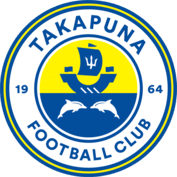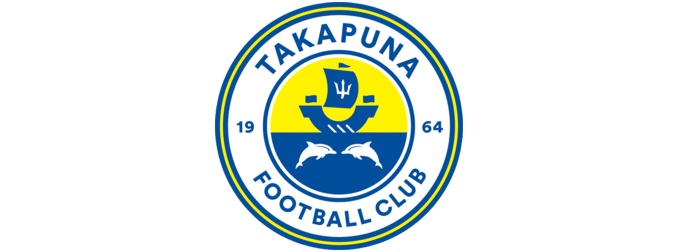Club History - Takapuna AFC 1964 - 2011
In 1963 a small band of residents headed by Don and Joan Quinnell decided that local kids deserved a football club of their own and applied for registration with the Auckland Football Association and were granted a start for 1964. They also applied to the Takapuna City Council for a home ground and space was allocated at Onewa domain where one main ground and a smaller practice pitch was marked out. Following this success a notice was placed in the North Shore Times Advertiser for players and parents willing to coach and be part of the committee to run the new club.
The first committee consisted of Messrs D.Quinnell, F O Bell, R Newbould, J Neuman, L Hope-ede, G Youngs, R Dean, R G Smith and E Jacobs. Regretfully it was noted Mr Dean passed away before the inaugural 1964 season started. Nine teams of juniors and three teams of midgets lined up for the first season each paying five shillings and two shillings and six pence respectively. Interestingly fifty six adults paid a non playing membership of ten shillings as a contribution to the start up costs of the club. The first ever junior team to win a championship was the 8th North A coached by Eric Jacobs in 1964.
A major step forward arrived in season 1966 with establishment of a first and reserve senior teams who played in the Second B division of the Northern League and Second B div. of the reserve league. This came about after much soul searching in the club re the cost of running senior teams but eventually it was accepted that the lack of a senior section of the club would eventually inhibit junior development. By this time the junior section had burgeoned to twelve junior and three midget teams. Mr Danny Daniels was the inaugural first team coach. At this time the Takapuna City Council advised of a ‘grand plan’ to improve the Onewa domain to include an athletics track and two football fields of international standard plus a hockey field. A grandstand and changing facility was included in the plan to serve football and hockey which, at the time, was admitted as a long term idea and never eventuated. The football teams changed in a converted tin garage with home players sharing their shed with tins of creosote, nets and pitch marking machines. Floodlights, of course, were a dream and at practice a quick game had to be fitted in before the light faded to only allow running up and down the pitch in the dark. Balls were painted with white each week to allow for better sight in the half light at training. Never the less in 1967 the three senior teams gained promotion. The second pitch, as promised, was established but not before a second world war concrete gun pit had been removed by club labour led by secretary Frank Bell and his trusty sledge hammer.
By the end of the ‘swinging sixties’ the first team coached by Alf Dickens won promotion as did the reserves and the juniors had fourteen teams backed by three midget sides. The new changing and amenities block was finally completed by the Council and the tin shed was consigned back to house equipment. Don and Joan Quinnell and Frank Bell were all made Life Members at the 1969 AGM in recognition of their services in starting the club. Despite sixteen being voted on to the committee for the following year it was reported that “ it was hoped that more supporters would offer their services in this direction”.
The opening season of the 1970s saw ex North Shore stalwart Don Jones take over as first team coach in the Auckland First division and win the league by a clear ten points to gain promotion to the Premier league. By this time the club had an additional three senior teams, thirteen juniors and two midget sides. Junior subs were $1 to join and 20c per game and midgets $1 and 15c. An urgent call was made for coaches and parents willing to transport teams to away games. Of interest in this year was Don Jones’ call for an amalgamated team drawn from all Shore teams to compete in the Rothmans National League (ahead of his time maybe) and an experiment in a friendly against Mt Wellington where there were no linesmen but two referees. Taka won 3 – 2 and obviously the experiment was never adopted. The first team took out the post season Leopard Tavern trophy by beating Massey Rovers 3 – 0 in the final at Mt Smart earning the club $200 and the cup. A major change for the club was started with early talks about swapping grounds with the Takapuna Rugby club. The Council promised to build new clubrooms and provide a practise field at Barry’s Point in return for the club giving up our place at Onewa. Secretary Frank Bell was quoted as saying that one of the benefits was the club not having to share space with athletics or cricket – an advantage with the seasons starting earlier nowadays.
The start of season 1971 saw Takapuna with fifteen juniors and five midget teams and the first team beat Whangarei 10 – 1 at Onewa to start a stellar season going toe for toe with North Shore until the last game of the season where Takapuna beat East Coast Bays 3 – 1 at Newmarket Park on the 22nd September to enter the playoffs for the National league. This was on top of getting as far as the quarter finals of the Chatham Cup, bowing out to Dunedin Suburbs 3 – 1 at Newmarket Park. In a playoff involving New Brighton of Christchurch, Western Suburbs and Waterside of Wellington Takapuna came up short by one point and missed out despite healthy wins against Waterside in particular, beating New Brighton away and coming back from four goals down to draw with Western Suburbs four all at Queen Elizabeth II Park. After three successive seasons of promotion this was a setback. Well known reporter Trevor Rowse said at the end - “So to Don Jones, his team and all the workers in the club – congratulations. You have done with spirit what other clubs could not do with importations and costly wages”.
There were nineteen junior and four midget teams to start the 1972 but as far as the first team were concerned there was a hangover from the previous glory year and the year ending in fourth place with the only highlight being the establishment of the club at the current home Taharoto Park. Don Jones returned to coach Shore to the National league in 1973 taking several key Takapuna players with him leaving new coach Argentine Vic Fernandez with an untested team of young Turks who were not yet mature enough and the club returned to Div. 2. This was only a temporary setback though as Vic’s introduction of young players during the previous season bore fruit in 1974 with promotion back to Div. 1 behind leaders Whangarei. At the end of the season, sadly, the popular player coach returned to Sydney to play and then coach in Canberra.
A succession of coaches followed : Alan Yates, ex first team old boys Bryan ‘Doc’ Loader and Tony Whitehouse without gaining promotion from the second tier. 1977 however saw the completion of the upstairs clubrooms and therefore our longstanding social venue, Trader Jacks bar at the Poenamo Hotel, became redundant. The premises were built with little money to spare and major contributions from first team players in the off season to help finish it off. First bar efforts consisted of a player, in full kit, racing off the field down to the local liquor merchant to purchase some crates of cold DB before the first players emerged from the showers. Thankfully the same brewery came up with a sponsorship of a new cooling system for draught beer the following season and we were away. So the latter half of the seventies did not produce the promotion sought by the club it was a great social time and slowly but surely some talent was being nurtured. In the last year of the decade a young reserve team under the astute management of club stalwart Brian Giblin won the league which was significant as this team was to contribute hugely to the club over the next three decades and beyond. Also in that last year the club appointed Ray Hill, who arrived from success with Tawa in Wellington, as first team coach.
The eighties started with bang with the first team winning the Country Foods Div 1 championship by four points from local rivals East Coast Bays and with that promotion to the Rothmans National League as well as a semi final place in the Chatham Cup going down narrowly to Dunedin in the penultimate game. Ray Hill was named Auckland coach of the year and at the club’s prize giving, Roger Collins was named player of the year with Peter Kilhams young player of the year. The stock market began to boom so it all looked promising for the following season – maybe.
As it turned out our only season in the National League 1981 was a huge drain on the club’s meagre budget and resources and in hindsight we may have been better off not taking part but, after much soul searching, the committee decided to go with the player’s desire to compete at the top level. On the field Ray Hill dropped some of the faithful players that were so good for him the year before and who had history in the club for some new faces who did not have so much of an affinity with Takapuna. Too many draws and not enough wins saw us dropped from the league at the end of the season by a narrow margin. 1981 also saw our juniors compete in the newly established North City Junior Association therefore negating the need to cross the bridge for away games. At the time subs were as follows : Senior $35, U18 & U19 $25, Juniors $17 and Midgets $10 - $5 of the junior / midget fee was refundable on return of the playing shirt at the end of the season. The hangover of the previous season stuck around in 1982 and saw the committee replace Ray Hill halfway through the season with Alan Yates who would make little impression that season or in 1983 and he would, in turn, be replaced by Bill McGowan.
Our first women’s team appeared in 1982 coached by Mike Chubb and featuring several wives, girlfriends and sisters of male players. The 80’s was a tempestuous decade which saw people almost sell their shirts to buy shares and life was great early on. Bill McGowan started building a side around our first imported player Dave Mitcheson from Blyth Spartans in the English north east. The club came in 6th place in 1984 then went on to win the Premier league the following year on the last day of the season where Howick only had to draw against lowly Papakura to take the title but lost on the day allowing us in care of a win against Metro. We also reached the final of the Country Foods cup at Mt Smart losing 4 – 2 in extra time to Mt Maunganui. In that season saw another import Gary Churchhouse played a major role especially as we reached the play offs for the last National league spot in a round robin of teams played in Palmerston North. Again the club gave the players a shot despite the expense but we came up just short. After a couple of dull seasons in 1986 and 87 we again won the Premier league with the help of Mickey Strachan and Steve Holden who joined for a season from Fleetwood Town who were rated as possibly our best two ever imports at that time. The National League was by invitation at that time and as the club had a massive debt due to unfulfilled sponsorship by supporting companies who went down in the late 80s financial crash the club could not meet the criteria. So the decade ended with a debt of about $38k and a team of club stalwarts playing out our 1989 season under club old boy Mike Chubb. Despite having a dedicated team of good club lads we were relegated into the first division where we were to stay for some time during the next 10 years.
A succession of coaches and players kept us up in the first division of the Northern league without managing to get to the top two promotional spots for the Premier division. The club became a smaller entity with the growth of neighbours Forrest Hill, Glenfield and Albany but we managed to clear our debts and still maintain our profile as a good solid club who made all welcome. In his last year as coach after three seasons Sid Roden got to third place with a handy team which included probably our best overseas player Paul Hobson who joined us from Papatoetoe. Wayne ‘Grumpy’ Hallford who had begun playing for the club back in the Onewa domain days took over the coaching role in 1999 and we won promotion back to the Premier league as well as reaching the semi final of the Chatham Cup on a memorable day at Waitakere where we were dreadfully unlucky to go down 4 – 0. The chaotic scenes back at our club where the party raged until late were more like a win than a loss such was the togetherness of the whole club at that time. The decade rounded off well with the U17 men’s World Cup at North harbour stadium.
The 2000’s started reasonably and typical of a season after a great result the year before we reached mid table in the Northern premier league before Grumpy gave way to former All White Billy Harris who coached us to respectable finishes in 2001 and 2002 only to see the club relegated in successive seasons 2004 and 2005 under the worthy Andy Hamilton doing his best with what he had to play with. ‘Grumpy’ Hallford returned with Shayne Major to steady the ship and begin the fight back. In 2007 Alan Yates returned to team up with Hallford winning the second division with a last gasp win away in Cambridge. In the meantime our parent body United Soccer 1 had implemented their plan to play all of their local teams in a federation only league thus finally withdrawing all teams under their control from the Northern league, a move not popular with the clubs involved. So in 2007 we found ourselves playing the likes of East Coast Bays, Waitakere etc. in the local premier league for the next three years under Grumpy then Clive Campbell who coached until 2010 in which season the club’s prevailed and our first team and reserves were reinstated to a new look Northern Premier league. Despite playing some great football we couldn’t prevail against more costly opposition and going into season 2011 we were in the First Division of the Northern League.
If you have had the patience to read four pages of history I hope you have seen that the club has had its period in the sun like many clubs have and I would have loved to have mentioned all the individual players, hardworking administrators and club characters plus the many stories that could be told but I would have ended up writing a book. Despite being the smallest club on the Shore we still have a reasonable profile and continue to work hard for our members and for the various charities that we support.
To be continued..../

Contact
Phone: 09 4898410
Email: admin@takapunaafc.co.nz
Address: 13 Taharoto Road, Takapuna, Akl
PO Box: 33 600, Takapuna, Akl, 0740









 Admin Login
Admin Login